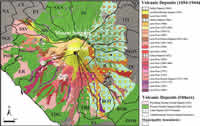Volcanoclastic flow hazard assessment in highly populated areas: a GIS-based approach applied to Torre del Greco municipality (Somma-Vesuvius, Italy)
Bisson M., A. Paolillo, A. Tadini, R. Sulpizio, G. Zanchetta (2017).
Geosciences Journal, doi: https://doi.org/10.1007/s12303-017-0060-2.
Abstract
This paper presents a contribution to Volcanoclastic Flows hazard assessment in very densely populated volcanic areas by using a multidisciplinary study applied to the Torre del Greco area, a municipality close to the active Somma-Vesuvius volcano, in Italy. This study integrates and combines in a GIS environment several types of data: i) information on Volcanoclastic Flows recorded during the years 1906–2010, derived from historical chronicles and local reports; ii) rainfall data relative to the investigated period; iii) summary of the recent activity of Somma-Vesuvius (AD 1631–AD 1944) deriving from the scientific literature; iv) morphological and morphometric analyses derived from a very high resolution Digital Elevation Model developed in the years 2009–2012. The historical analysis of the spatial and temporal distribution of the Volcanoclastic Flows recorded in the Vesuvian area during the last 104 years indicates that the zone mostly affected by such phenomena is the south-western sector of Somma-Vesuvius, and in particular the Torre del Greco municipality, for which a specific database on paths and directions of the historical Volcanoclastic Flows was implemented. The analysis and comparison of all available data allowed us to: i) recognize that the source zone of Volcanoclastic Flows occurred in Torre del Greco was a funnel-shaped area located immediately SW of the Somma-Vesuvius caldera boundary and just above the most urbanized area of the town; ii) individuate the key morphometric parameters (slope and curvature) necessary for the potential triggering of Volcanoclastic Flows; and iii) investigate possible relationships between the fallout deposits of the Somma-Vesuvius main recent eruptions and the historical Volcanoclastic Flows of Torre del Greco. Although this approach represents only a starting point for studies aimed at the assessment and mitigation of Volcanoclastic Flows hazard, it can be applied in other volcanic zones having similar characteristics to the Somma-Vesuvius area. Moreover, it can be used not only during a period of volcanic quiescence when heavy and/or persistent rains are able to remobilize loose pyroclastic deposits, but also in syn-eruptive conditions.


